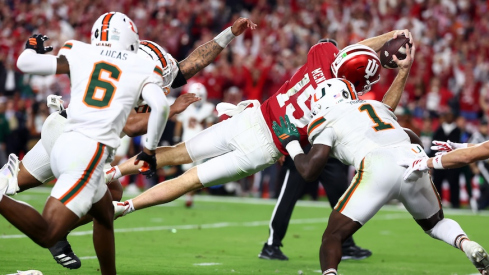In the super badass post-apocalyptic movie Mad Max: Fury Road, there's this plot thread where one of the protagonists is constantly talking about a "green place," a land she hasn't seen since childhood that's unafflicted by the blight and radiation and general crappiness that the rest of the world has suffered from due to nuclear fallout or rampant kangaroo attacks or whatever the hell happened in the Mad Max world to make it suck so badly.
Anyway, everyone ends up heading toward this green place, and on the way they go through this gross swampy morass that's populated by dudes on stilts and their crow buddies. "This place is terrible, welp good thing that the green place is so cool," says everyone, right before they find out that the green place was in fact the fetid bog they had just crossed, destroyed by years of unchecked crow pollution.
Schools who think that they're finding their own green place by heading to the Big Ten are starting to see the same scales fall from their eyes that Furiosa did. Instead of a verdant world filled with fat, happy programs ripe for picking by opportunistic outsiders, the Big Ten is a violent, barren football and basketball wasteland. Only the strong survive here. Maryland, Rutgers, Nebraska... look to Penn State! Behold their stilts!
Any poor souls that trespass against us, whether it be beast or man
I wish I were just a little bit older, sometimes. Not always, or usually; I like having functional knees and the ability to put on socks without planning a contingency plan. But on the other hand, I also like context, and I can't help but feel that as a college football fan who was born in 1985 and wasn't really conscious of the various beefs that existed throughout, I've missed some really great late-80s-to-mid 90s trash talk that I could throw on to the lawns of opposing teams in the year two thousand and eighteen.
Penn State as an independent football power was probably something really awesome to behold. With Joe Paterno still wearing a halo instead of carrying a pitchfork and Happy Valley tucked away in the central Pennsylvania lowlands like some kind of Rust Belt Rivendell, the Nittany Lions kicking enormous amounts of football ass in the 80s probably got a lot of people hot and bothered when they made the jump to the Big Ten.
The 1980s was the best decade in the history of the Penn State football program. They had seven bowl wins, four finishes in the top five of the AP Poll, and their only two national championships, one of which came as a result of an upset of a really douchey Miami team. It's possible that Paterno and company thought that they could roll into the Big Ten and set themselves up for a long period of Pax Nittanya in the Midwest, but the truth is actually more simple than that.
Will suffer the bite or be stung dead on sight, by those who inhabit this land
The real reason why Penn State was so attracted to the greatest collegiate sports conference in America was probably this little factoid tucked in the corners of a New York Times article about their transition:
Penn State, which has been struggling to support 28 varsity sports primarily from revenue earned by its football team, joining the Big Ten should produce a net financial gain. For example, although it will have to share post-season revenue with its new partners, it will also share in such revenue earned by other Big Ten schools. It will also be able to qualify for the Rose Bowl, by far the most lucrative of the college bowl games.
This paid dividends almost immediately, because a year after Penn State joined the Big Ten in 1993, they went to their first Rose Bowl since 1922 and won the conference championship. Then the reality of playing in the same conference as Michigan and Ohio State began to set in, and while the win totals stayed high for most of the 90s, championships and Rose Bowls didn't come with any sort of regularity: Penn State has been to two Rose Bowls since 1994, lost them both, and have won the conference three times.
For comparison's sake, in that same time frame Ohio State has 11 conference titles and two Rose Bowl victories.
Granted, Penn State has made buttloads of money from being in the Big Ten. Whatever sports glory they may have sought, the financial gains from joining up with the likes of the Midwest Superfriends have probably made up for being a medium-sized fish in a medium-sized pond.
Penn State football has seemingly rebounded from scandal, relegation to B-tier status, and general malaise, but it's taken them the better part of three decades to do it after they joined the Big Ten. You'd think that would be a warning for other marquee programs that have wanted to link up with the conference in pursuit of either riches or glory, but it hasn't prevented Nebraska football or Maryland basketball from suffering similar fates.
For theirs is the power and this is their kingdom, as sure as the sun does burn
Nebraska football is an interesting case, in that conference reorganization has bit them twice now. In the old Big Eight conference, the Cornhuskers dominated, despite playing against the Sooners on a regular basis. In fact, what might surprise people is that in the history of the Big Eight, Nebraska won 41 football titles to Oklahoma's 34, including the last five of the conference's existence.
Then they joined up with the Texas Longhorns and three other Lone Star state universities, and won only two conference championships from 1996 until joining the Big Ten, which they've never been the champions of. That's actually damning with faint damning; the Nebraska Cornhuskers haven't finished ranked higher than 20th in the final AP Poll since 2009, and haven't finished ranked at all since 2013.
Time will tell if the same fate befalls Maryland basketball, a program with a storied history of success while also playing in one of the most difficult conferences in the country. Eking out a national championship while under the thumb of Duke and UNC was no small feat for legendary Terrapin coach Gary Williams, and his successor, Mark Turgeon, probably couldn't be blamed for being excited about joining the Big Ten. And he's been fine, but with diminishing results each season. The Terps just got bounced from the Big Ten tournament by Wisconsin, and are staring the NIT in the face after making the NCAA tournament in their first three seasons in the league.
Rutgers... well, Rutgers is Rutgers. They're trying, but their entry was more nakedly financial (from both sides) than it was about any kind of athletic prestige. The Big Ten got access to the New York City media market, and Rutgers got an Uncle Pennybags to cover their empty pocketbooks. Suffice to say, they haven't made March Madness since 1991, and have lost 31 games in four seasons in Big Ten football. Rutgers basketball did just beat Indiana in the Big Ten tournament, however, which is fun.
So enter this path, but heed these four words: you shall never return
Here's the rub for schools that have opted to join the Big Ten: you are going to make a lot of money. Like, a huge boatload of money that you can pull into the nearest semi-crooked construction company and have them build whatever facilities you think you'll need to foist yourself up to the level of the Clemsons and the Alabamas of the world. The problem is that those schools, including several that are already in your new conference, have all of those advantages that you seek. A simple address change isn't going to solve the problem of starting a lap behind.
A lot of that can be mitigated through coaching. James Franklin has done crazy things at Penn State to get them back in the thick of it, Chris Ash is trying his hardest, and it's easy for Nebraska fans to be excited about Scott Frost.
Still, the Big Ten is and always has been a swamp. A swamp filled with cold hard cash, yes, but also a swamp filled with ogres and stilt-men and that weird tentacle monster from Star Wars.
Enter at your own risk.


